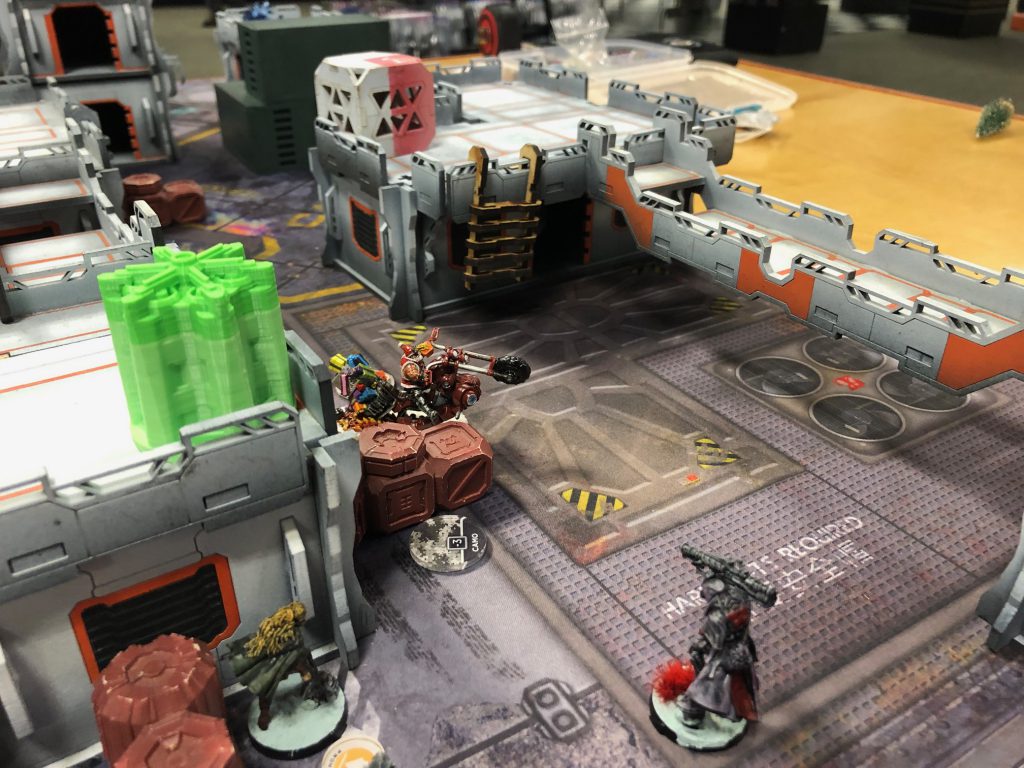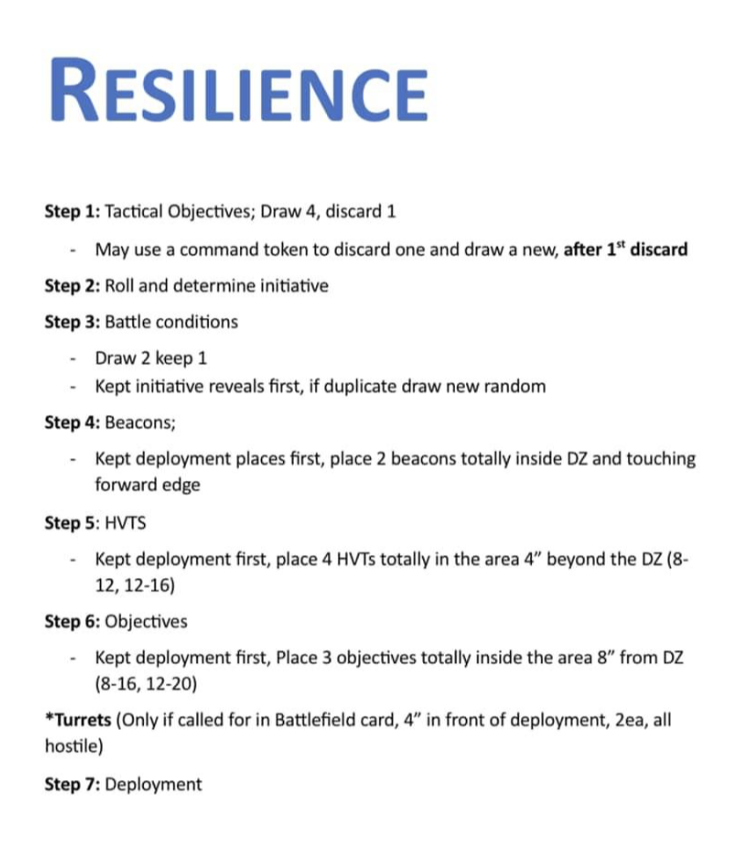Infinity is well known for its complex scenarios that rotate with the release of each new Infinity Tournament System (ITS) season. There are a ton of different choices for ITS scenarios with the current season containing an impressive twenty different missions. While some of these missions share some themes, each one has extremely specific rules that are included to make them unique. For example, there are few different scenarios where the overall objective is to kill your opponent’s models, however each different scenario based around killing has its own spin to make it unique. Some of these scenarios introduce defense turrets, while some change the game up drastically by making a biotechnical virus do damage to any models who don’t move towards the center of the board.
This scenario system works extremely well for a tournament setting where players can bring two different army lists and tailor those lists to the scenarios in the tournament pack, but it can sometimes cause confusion or bad match ups for a simple pick-up game of Infinity. I certainly wouldn’t want to bring the same Shasvastii list to a mission with an exclusion zone where I cannot make use of their increased availability of infiltrating troops as I would to a mission where my Shasvastii would be free to deploy their infiltrators right up to the middle of the table. Thankfully, Corvus Belli has released a new type of mission pack for Infinity called Resilience Operations. This new mission pack revolves around a card-based system that is included in the ITS Season 15 Classified Mission Deck, and it provides a refreshing way to play the game of Infinity while still keeping true to its scenario based roots.

In Resilience Operations, each player draws four objective cards from a deck that is included in the standard Infinity Classified Objectives card pack and picks three out of the four cards to create their objectives for the game. Each player also draws an additional card from a battlefield conditions deck that will have an affect on the terrain on the tabletop, or adds defensive turrets to the mission, or even makes the HVTs on the table hostile (which is hilarious since you place FOUR HVTs in Resilience Ops). Playing a game of Resilience Operations takes a little set up just prior to starting the game, but it takes zero pre-planning on the part of the players and a wide variety of army lists will do just fine in completing the objectives in the vast majority of the Resilience Operations card pack. That is really the draw to using this new mission system. It is extremely pick-up-and-play friendly. Well, once you get down the steps on how to set up for a game of Resilience Operations…then after that it’s pick-up-and-play.
Instead of painstakingly listing out how to set up a game of Resilience Operations, I will include the below step-by-step guide which was provided to me by our local TO before our first Resilience Operations event. This little cheat sheet saved us a ton of time and was a perfect addition to the Resilience Operations event (smart move Ed).

The Best Things About Resilience Operations
Resilience Operations completely solve the problem of having to tailor your army list to a specific mission. I am playing in a tournament later this month with my Shasvastii and Biotechvore is one of the missions Multiple people have warned me I need to carefully construct a list with the scenario rules for Biotechvore in mind. There are many scenarios like this in ITS15. The two list format for Infinity tournaments makes these types of missions work well in a tournament setting, but what if I just showed up to Infinity game night with a normal Shasvastii list and my opponent wanted to play this weird mission? The Infinity gaming community is slightly different than others in that players seem to pick the mission they will be playing on pick up game night even before building an army list, but this takes prior communication and planning with your opponent that sometimes just doesn’t happen. Sometimes players just want to show up to their game store with their generic army list and play a game.
This is where Resilience Operations really shine. With the ability to cycle out two of your objective cards (the second one will cost a Command Token but it is totally worth it to get a better Objective!), and the scoring of objectives being open to more model types than in ITS missions, many more army lists are viable in Resilience Operations than in the ITS15 scenarios. The asymmetrical objectives of this game mode really add some excitement to games when trying to figure out just what your opponent is trying to accomplish to score their points while simultaneously scoring your own without tipping your opponent off too early to your plans.

The Not-Best Things About Resilience Operations
The biggest downside of this game mode is the multiple hoops players need to jump through in order to even start a game of Resilience Operations. As shown in the seven step set-up process, each player is placing multiple objects on the table for every single game. Depending on which objective cards are drawn, a player could need to interact with Beepers, Objectives, HVTs, Turrets, Beacons, Bumper Stickers…you get the point. However, players won’t be interacting with all of these objects in each mission. It is entirely possible to draw a set of objectives where there is NO interaction with the objects that are placed for every single game. While not a big deal after getting the flow of setting up a Resilience Operation game down, these steps can seem like a lot for a game mode that is designed to be the pick-up-and-play of Infinity scenarios.
The second slight downside to these missions is something that was also listed as a positive. The asymmetrical style of the missions can be a downside depending on you and your opponent’s card draws. Some of the mission cards pair better than with others, and some of the mission cards are insanely easy to complete compared to others (looking at you, hold your own three Objectives card). In normal ITS15 missions each player has a clear idea of what their opponent is trying to accomplish, and that just isn’t the case in Resilience Operations. While this fog of war can add some excitement to games as you attempt to figure out just what objectives your opponent is trying to complete, it can also be feel like each player is playing their own separate game of Infinity just trying to score points.
Final Thoughts
Depending on the Infinity meta that you play in currently, players may be getting a little tired of the ITS15 missions, and Resilience Operations can be an amazing way to refresh an Infinity community. I recently went to a Resilience Operations tournament and the players all seemed excited to try out these scenarios in a tournament setting and not worry about if they included enough Specialists in their army lists.
With just a couple of manageable downsides, Resilience Operations is a great fresh scenario system for Infinity. Depending on what you are looking to get out of your Infinity gaming experience, Resilience Operations will be a great new way to experience the game. Looking for an amazing pick-up-and-play scenario system to just bring whatever kind of cool Infinity list you want to play? Resilience Operations is perfect for that kind of game. Looking to run a tournament that changes it up from the standard ITS15 scenarios that your players are getting bored with? Resilience Operations can help with that too! By knowing the few downsides of this scenario pack, Resilience Operations can be a refreshing way to play Infinity that will stick around even after the community moves to ITS16.
Have any questions or feedback? Drop us a note in the comments below or email us at contact@goonhammer.com.



You must be logged in to post a comment.